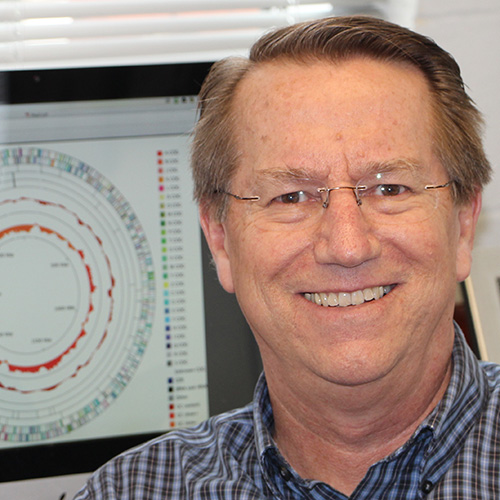Eric Miller
Bio
Our interests include the molecular biology and genomics of bacteriophages and bacteria. Bacteriophages are the single most abundant biological entities on earth, with estimates of over 1031 in number. Over several years, our experience has included working with phages that infect E. coli, Salmonella, Bacillus, Vibrio, Mycobacterium and currently Paenibacillus larvae, a pathogen of honey bees that causes American Foulbrood Disease (AFB). Phage genomics is extremely tractable since phage can be relatively easily isolated, the current cost of DNA sequencing is low, and assembly and annotation of phage genomes is readily learned and accomplished. Graduate students and undergraduates can participate in a variety of projects with fairly short learning curves. We are pursuing P. larvae phage isolation, genome characterization and analysis of specific phage gene and protein functions of interest. Some of this work could impact our understanding and treatment of AFB.
We also have microbiology projects involving collaborators on campus that include studies of novel tetrapyrroles (tolyporphins) produced by filamentous cyanobacteria (with Dr. Jon Lindsey), the enzymes of isobutylene catabolism by Mycobacterium sp. ELW1 (with Dr. Michael Hyman), and indicators of disease in honey bees (with Dr. David Tarpy). Students and research scientists at all levels are involved in this work. Contact us at any time if you’d like to discuss one of these projects.
Our undergraduate research program funded by the USDA, BeeMORE: Bees and microbes in organized research and extension, provides underrepresented students in science and agriculture from across the country an opportunity to participate in hands-on research and professional development. Visit the website on how to apply!
Websites we visit:
- American Society for Microbiology
- Genomics & Microbiology Research Lab at the NC Museum of Natural Sciences
- BacterioFiles, the podcast for microbe lovers (from NCSU PhD graduate Jesse Noar)
- SEA-PHAGES, HHMI Science Education Alliance
- The RAST server
- Habitat for Humanity, Food Bank NC, El Pueblo, Billy Strings, IBMA guitar player of the year (2021)
Courses taught:
- MB(GN) 758 Microbial Genetics and Genomics (Spring; Graduate)
- MB(BIT) 210 Phage Hunters (on hiatus)
View Publications on Google Scholar
Education
Ph.D. Biological Sciences Purdue University 1982
B.A. Microbiology California State University 1977
Area(s) of Expertise
Bacteriophage; microbial genetics and genomics; biotechnology
Publications
- Tolyporphins-Exotic Tetrapyrrole Pigments in a Cyanobacterium-A Review , MOLECULES (2023)
- Identification of Putative Biosynthetic Gene Clusters for Tolyporphins in Multiple Filamentous Cyanobacteria , LIFE-BASEL (2021)
- Natural Product Gene Clusters in the Filamentous Nostocales Cyanobacterium HT-58-2 , LIFE-BASEL (2021)
- Cellular localization of tolyporphins, unusual tetrapyrroles, in a microbial photosynthetic community determined using hyperspectral confocal fluorescence microscopy , Photosynthesis Research (2019)
- Genome sequence, metabolic properties and cyanobacterial attachment of Porphyrobacter sp. HT-58-2 isolated from a filamentous cyanobacterium–microbial consortium , Microbiology (2018)
- An inclusive Research Education Community (iREC): Impact of the SEA-PHAGES program on research outcomes and student learning , Proceedings of the National Academy of Sciences (2017)
- Genome Sequence and Composition of a Tolyporphin-Producing Cyanobacterium-Microbial Community , APPLIED AND ENVIRONMENTAL MICROBIOLOGY (2017)
- Mass spectrometric detection of chlorophyll a and the tetrapyrrole secondary metabolite tolyporphin A in the filamentous cyanobacterium HT-58-2. Approaches to high-throughput screening of intact cyanobacteria , JOURNAL OF PORPHYRINS AND PHTHALOCYANINES (2017)
- Photophysical Characterization of the Naturally Occurring Dioxobacteriochlorin Tolyporphin A and Synthetic Oxobacteriochlorin Analogues , PHOTOCHEMISTRY AND PHOTOBIOLOGY (2017)
- Quantitation of Tolyporphins, Diverse Tetrapyrrole Secondary Metabolites with Chlorophyll-Like Absorption, from a Filamentous Cyanobacterium-Microbial Community , Phytochemical Analysis (2017)
Grants
Our AFRI ELI (Undergraduate Research and Extension Experiential Learning Initiative) focuses on building student awareness and fundamental skills in the areas of microbiology and honey bee and other pollinator biology. We will educate participating students in the importance of honey bees as pollinators, the role of pollinators in crop productivity, and teach students the overall importance of microbes in earth ecology and the specific role of microbes in pollinator health and disease. This new BeeMORE (Bees and Microbes in Organized Research & Extension) proposal builds on our prior years of offering a successful summer REEU program for diverse students with limited exposure to agricultural research. The proposed program retains successful elements while enhancing the extension and science communication components of the program.
Our proposed AFRI ELI (Undergraduate Research and Extension Experiential Learning Initiative) focuses on building student awareness and fundamental skills in the areas of microbiology and honey bee biology. We will educate participating students in the importance of honey bees as pollinators, the role of pollinators in crop productivity, and teach students the overall importance of microbes in earth ecology and the specific role of microbes in honey bee health and disease.
Molecular tools will be developed to enable editing the genomes of antibiotic-producing microbes.
Terrestrial cyanobacteria are known to be veritable treasure-troves of secondary metabolites, many of which have important properties of value to human health, animal health, agriculture, and energy sciences. Selected strains of cyanobacteria will be cultured and examined for production of metabolites, including chlorophyll derivatives. Genomic analyses will be carried out when deemed informative.
This Exploratory Research Project will develop new phage-based detection systems for monitoring Vibrio spp. of food safety and shellfish health concern. Lytic phages infect viable cells where gene expression and phage amplification from nominal levels of vibrios can generate detectable biomolecules adaptable to convenient assay systems. Reporter phages and Quantum Dot nanocrystal technology will be configured for specificity in detecting V. parahaemolyticus, while employing parameters that reduce ?false positives? from the non-pathogenic vibrios in marine samples.
